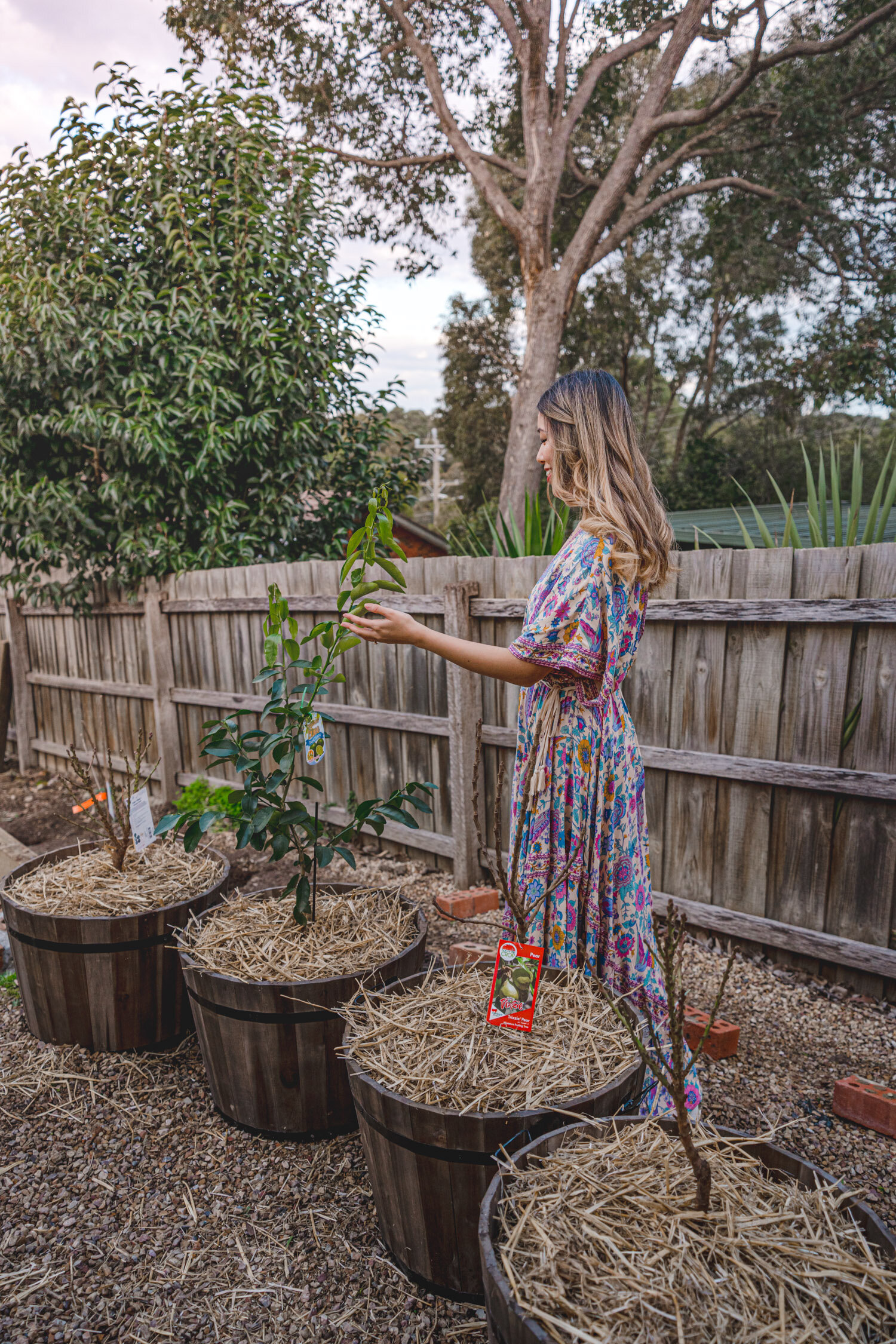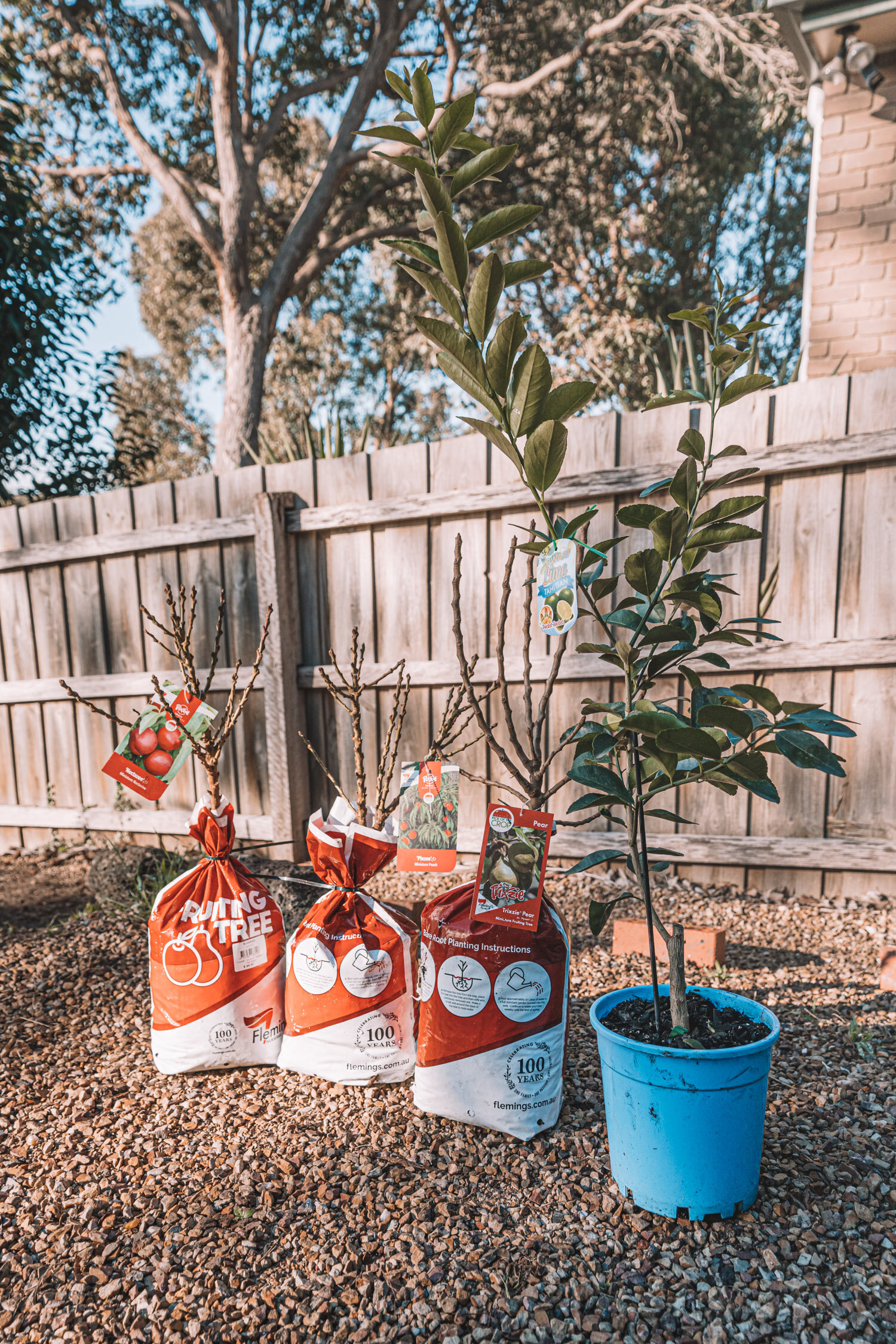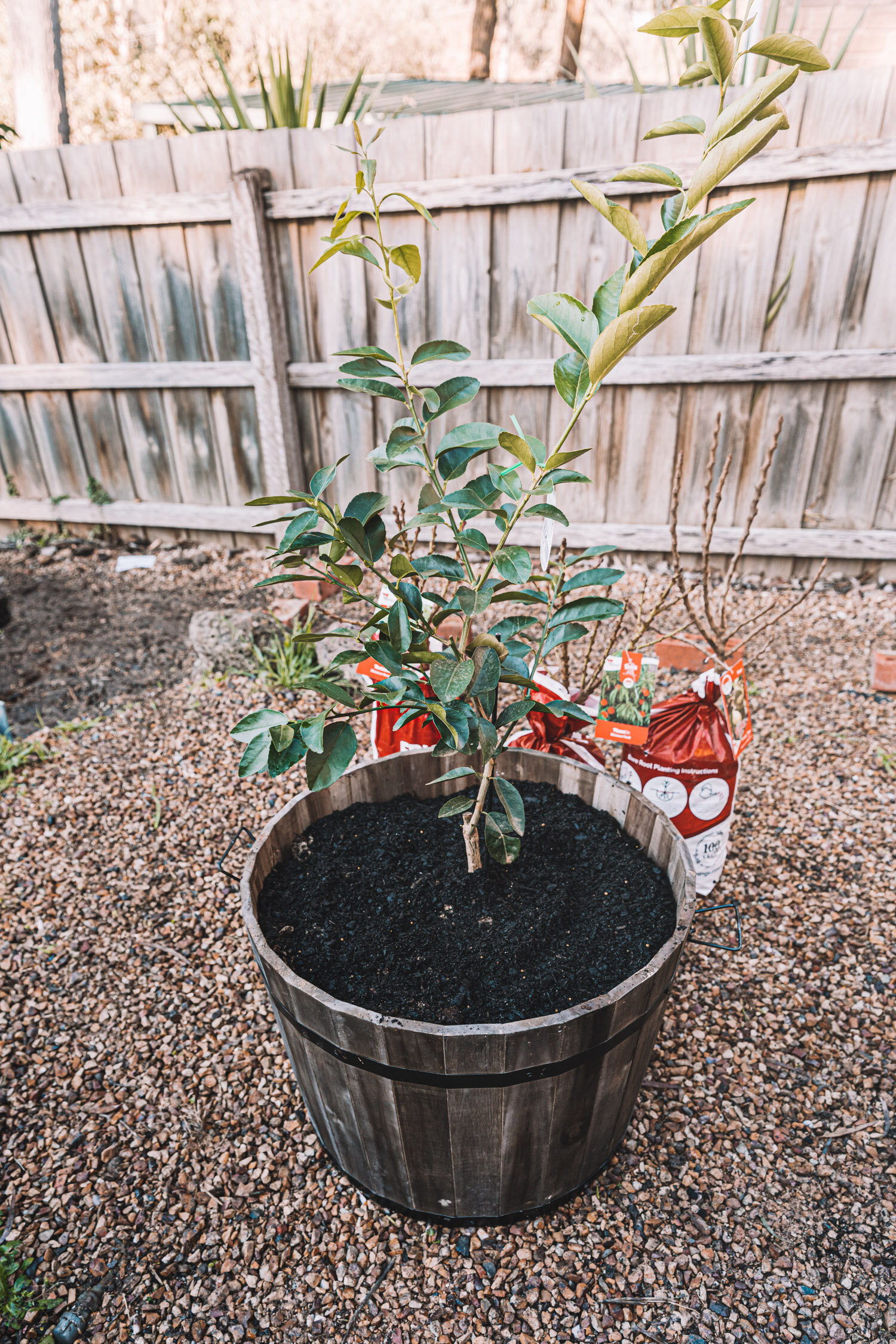How to Grow Fruit Trees in Containers!
Having fruit trees in our garden is one of my biggest dreams however sometimes the commitment of choosing exactly where to put them or waiting for your trees to fruit can stop a lot of people from delving into the fabulous world of home-grown fruit.
I know it has for my family. About 8 years ago when my parents moved in their new property (& I was still living at home), we all gushed at the fabulous garden space for fruit trees. They were excited to plant their veggies but when it came to fruit trees, my parents were unsure about how long they’d be living there. So they thought it wasn’t worth the effort putting in young fruit trees if by the time they finally got fruit, it was time to move house. Eight years later, and my parents are still living on the same property! And they so wished in hindsight that they put them in all those years ago, they would have been prolific by now!
Over the last few years though, in an effort to scratch the fruit tree itch, my parents did start growing a number of fruit trees in containers and I was pleasantly surprised by the success. I didn’t know fruit trees could grow well in containers and after learning more about this whilst studying for my permaculture design certificate last year, I’ve finally felt confident enough to grow my own fruit trees in containers & share my knowledge with you too.
Wearing: Spell Lovebird Gown + Bared Firecrest white leather boots
WHY GROW FRUIT TREES IN CONTAINERS?
Growing fruit trees in containers has so many benefits!
By growing in containers, you can enjoy home-grown fruit even if you’re renting or planning to move houses regularly or in the future. Just pack up your potted trees and bring them with you.
The fruit tree cultivars that are suited for containers typically grow much smaller in size than standard fruit trees, meaning you can fit MORE VARIETIES in your garden without taking up so much space.
Growing in containers allows you to move your fruit trees around your garden, so that they can better access sunlight, etc throughout the seasons.
Growing fruit trees in containers gives you flexibility. You don’t have to make any decisions about where exactly to put it in the garden.
Growing fruit trees in containers is often less physical labour. You don’t have to spend weeks digging holes in your garden.
Growing fruit trees in containers means you can control the exact growing medium you use, instead of trying to fix your garden soil.
Growing fruit trees in containers is easy, just follow the below guide!
HOW TO CHOOSE FRUIT TREES FOR CONTAINERS
The trick to growing fruit trees well in containers is knowing what fruit tree cultivars work for containers.
To put it simply - free trees come in different sizes and this size is determined by the rootstock in which the fruit tree is grafted onto. When choosing fruit trees for containers, choose ones that are dwarf or super dwarf, rather than full sized fruit trees.
Super dwarf fruit trees are the smallest fruit tree size and typically grow around 1.5 metres in height but still produce full sized fruit. These are perfect for containers, however there aren’t that many super dwarf cultivars out there to choose from.
Dwarf fruit trees are the typical small fruit tree and grow up to around 2-3 metres in height. You can get many different fruit trees in dwarf size these days and these are the fruit trees suburban dwellers should be going for.
Most unlabelled fruit trees are full size fruit trees and most of these will grow very large up to 5-7 metres in height depending on variety.
The smaller fruit trees (super dwarf and dwarfs) are usually more expensive than the full size fruit trees. However, they are worth the cost for suburban gardens. Full size fruit trees simply take up too much space and their tall size makes it difficult to harvest your fruit. Of course, if you’re growing for other reasons or in a really large rural property, then this might work for you. But even then, the height of dwarf fruit trees still make them a practical choice.
So when shopping for fruit trees, make sure you read the label and choose accordingly. I got all my fruit trees from Bunnings - you will generally see the dwarf fruit trees placed next to the (cheaper) full sized tree of the cultivar. Make sure you pick up the right one!
SOME SUGGESTED FRUIT TREE CULTIVARS
If you want to grow nectarines: try the super dwarf Trixzie Nectazee Nectarine. This compact tree is perfect for containers and grows full sized yellow fleshed nectarines. It’s self pollinating too meaning that it does not need another nectarine tree around to ensure this one grows fruit. Grows up to around 1.5metres tall.
If you want to grow peaches: try the super dwarf Trixzie Pixzee peach. This compact fruit tree is also self pollinating with full sized yellow fleshed peaches. Grows up to around 1.5metres tall.
If you want to grow pears: try the super dwarf Trixzie Pear cv. Pyvert. This compact fruit tree is self pollinating (!!) with full sized pears, growing up to around 1.5 metres. Note, if you grow any other variety of dwarf pears, make sure to check the pollination guide as most (if not all) other pear trees require an additional pear tree of a specific cultivar to get fruit.
If you want to grow lemons: try the lemon lots of lemons. This fruit tree is a dwarf form of the popular Meyer lemon tree and is great for pots. Grow this tree in a spot with full sun. Grows up to around 1.5metres tall. Self pollinating.
If you want to grow limes: try the dwarf tahitian lime. Perfect for lime juice, grow this tree in a spot with full sun. Grows up to around 1.5metres tall. Self pollinating.
Today I’m planting the below four fruit tree cultivars in containers:
Dwarf tahitian lime
Trixzie Pear
Trixzie Pixzee Minature Peach
Trixzie Nectazee Nectarine
I found all of these all at Bunnings and find that it’s best to go to stores with bigger nurseries as they stock a larger selection of trees to choose from.
In the photo above, you can see that the pear, peach and nectarine tree are leaf-less twigs - this is because they are deciduous fruit trees, meaning they are a type of tree that blossoms in spring, fruits in summer, sheds autumn leaves and goes bare in winter. When shopping for deciduous fruit trees, the best time to shop (& plant) them is during winter when they are dormant. During then, nurseries are able to sell these trees bare-rooted. This can mean as a stick without any soil, or sometimes nurseries will package them up in plastic bags (as above), as well as in pots (but this costs the most). This kind of packaging is cheaper for the nursery, meaning that you too, can pick these trees up for a cheaper cost. I picked up the 3 Trixzie fruit trees bagged, which came to $50 per tree however if you want them in pots with soil, then it would be $65.
The lime tree however, is an evergreen fruit tree, meaning it keeps its leaves all season long - hence the name evergreen! I also picked this up from Bunnings - make sure to pick up the dwarf version - it’ll say so on the tag.
HOW TO PLANT YOUR FRUIT TREE IN A CONTAINER
YOU WILL NEED
Your fruit tree
A large container/pot: go for at least around 50cm in height/diameter. I’m absolutely in love with these Tuscan Path half barrel pots I found at Bunnings which look so gorgeous when you have multiple displayed together.
Potting mix: if you are a beginner and are feeling overwhelmed with the idea of planting a fruit tree OR if you want to keep things simple, then I highly suggest using a product like Osmocote Citrus & Fruit Premium Potting Mix. This product is a soil blend where they have mixed in all the different parts needed for growing fruit trees including the nutrition your tree would need for the first six months.
To calculate how much potting mix you need, you’ll need to do some maths. First, figure out the approximate volume of your pot. Then convert this into litres.
Mulch (e.g. pea straw)
Scrap fabric
INSTRUCTIONS
HANDY TIP:
Before you begin, it’s preferable to pot your fruit tree up near where you want it to go, as once it’s potted up, it can be quite heavy to move.
1. Prepare your container for fruit tree planting. With the half barrel pots I’m using, they only have one drainage hole in the middle and so I decided to add a few more by using a drill and drilling 4 extra holes at 1cm in size.
2. As the holes are quite large and you don’t want soil falling through, place a few fabric squares on top, so that water can seep through whilst keeping the soil still in the pot.
3. Fill your pot half-way with Osmocote Citrus & Fruit Premium Potting Mix. Then, place your fruit tree in the centre, making sure the level it is sitting at is at the same level it was previously sitting at. If you’re not sure, make sure the graft (the part where you can see a knob - this is where the rootstock was joined to the fruit tree) is at least around 5cm above the soil level.
4. Fill the remainder of the pot with potting mix.
5. Water your newly potted up fruit tree thoroughly, to ensure that all air pockets are gone and top up with a little more potting mix if necessary.
6. Dilute some Seasol per instructions and water your fruit tree. This helps nourish the tree during the stressful transplanting process and reduces transplant shock.
7. Add a 5cm layer of mulch (pea straw is my personal preference, but I have leftover hay in our garden so used that instead). This helps keep water from evaporating especially in the summer months.
8. If you’re planning to put your fruit tree on a timber deck or somewhere where you don’t want the surface to get water stained, you can consider using a pot stand or pot feet which is a mini stand for your pot and is also great for providing air flow through the bottom of the pot.
FEEDING:
Fruit trees get hungry too so be sure to pick up a fertiliser such as the Osmocote Plus Organics fruit and citrus fertiliser. Follow the instructions on the product and fertilise accordingly. Generally, fruit trees need to be fertilised right before/during the growing season when they are most hungry. However, if your fruit tree is still young and not bearing fruit yet, you can fertilise it maybe at half the rate the product says.
If you are using the Osmocote Citrus & Fruit Premium Potting Mix as per above, then you don’t need to feed your plant for the first six months as the food is already contained within the mix and will last for six months.
I hope you found this guide helpful and happy fruit tree planting!















